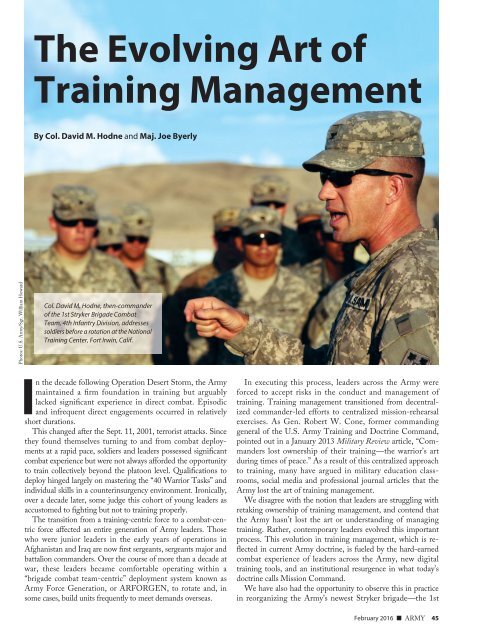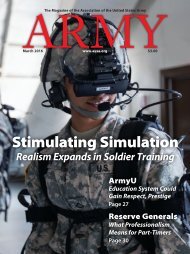Army - Kicking Tires On Jltv
Create successful ePaper yourself
Turn your PDF publications into a flip-book with our unique Google optimized e-Paper software.
The Evolving Art of<br />
Training Management<br />
By Col. David M. Hodne and Maj. Joe Byerly<br />
Photos: U.S. <strong>Army</strong>/Sgt. William Howard<br />
Col. David M. Hodne, then-commander<br />
of the 1st Stryker Brigade Combat<br />
Team, 4th Infantry Division, addresses<br />
soldiers before a rotation at the National<br />
Training Center, Fort Irwin, Calif.<br />
In the decade following Operation Desert Storm, the <strong>Army</strong><br />
maintained a firm foundation in training but arguably<br />
lacked significant experience in direct combat. Episodic<br />
and infrequent direct engagements occurred in relatively<br />
short durations.<br />
This changed after the Sept. 11, 2001, terrorist attacks. Since<br />
they found themselves turning to and from combat deployments<br />
at a rapid pace, soldiers and leaders possessed significant<br />
combat experience but were not always afforded the opportunity<br />
to train collectively beyond the platoon level. Qualifications to<br />
deploy hinged largely on mastering the “40 Warrior Tasks” and<br />
individual skills in a counterinsurgency environment. Ironically,<br />
over a decade later, some judge this cohort of young leaders as<br />
accustomed to fighting but not to training properly.<br />
The transition from a training-centric force to a combat-centric<br />
force affected an entire generation of <strong>Army</strong> leaders. Those<br />
who were junior leaders in the early years of operations in<br />
Afghanistan and Iraq are now first sergeants, sergeants major and<br />
battalion commanders. Over the course of more than a decade at<br />
war, these leaders became comfortable operating within a<br />
“brigade combat team-centric” deployment system known as<br />
<strong>Army</strong> Force Generation, or ARFORGEN, to rotate and, in<br />
some cases, build units frequently to meet demands overseas.<br />
In executing this process, leaders across the <strong>Army</strong> were<br />
forced to accept risks in the conduct and management of<br />
training. Training management transitioned from decentralized<br />
commander-led efforts to centralized mission-rehearsal<br />
exercises. As Gen. Robert W. Cone, former commanding<br />
general of the U.S. <strong>Army</strong> Training and Doctrine Command,<br />
pointed out in a January 2013 Military Review article, “Commanders<br />
lost ownership of their training—the warrior’s art<br />
during times of peace.” As a result of this centralized approach<br />
to training, many have argued in military education classrooms,<br />
social media and professional journal articles that the<br />
<strong>Army</strong> lost the art of training management.<br />
We disagree with the notion that leaders are struggling with<br />
retaking ownership of training management, and contend that<br />
the <strong>Army</strong> hasn’t lost the art or understanding of managing<br />
training. Rather, contemporary leaders evolved this important<br />
process. This evolution in training management, which is reflected<br />
in current <strong>Army</strong> doctrine, is fueled by the hard-earned<br />
combat experience of leaders across the <strong>Army</strong>, new digital<br />
training tools, and an institutional resurgence in what today’s<br />
doctrine calls Mission Command.<br />
We have also had the opportunity to observe this in practice<br />
in reorganizing the <strong>Army</strong>’s newest Stryker brigade—the 1st<br />
February 2016 ■ ARMY 45

















